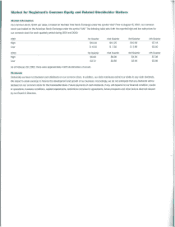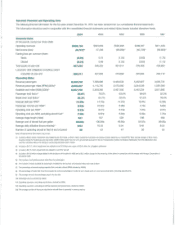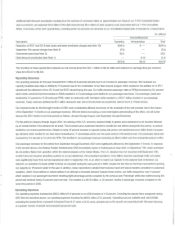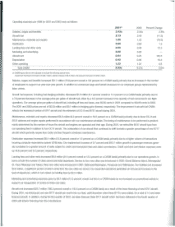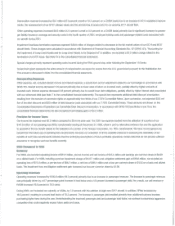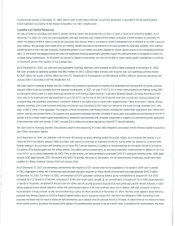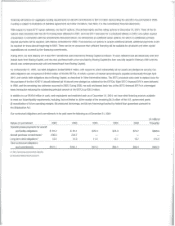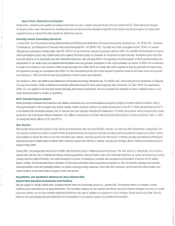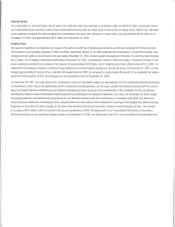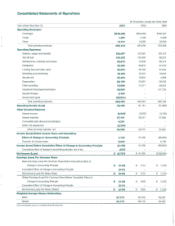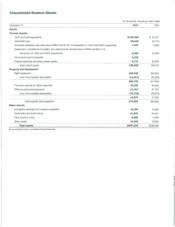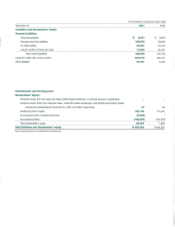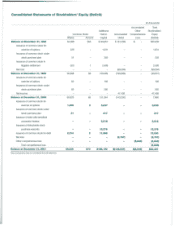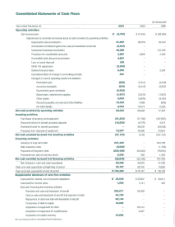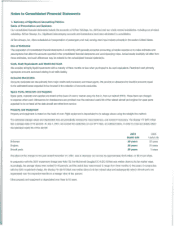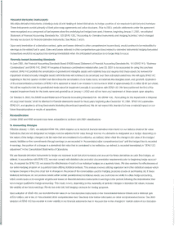Airtran 2001 Annual Report Download - page 18
Download and view the complete annual report
Please find page 18 of the 2001 Airtran annual report below. You can navigate through the pages in the report by either clicking on the pages listed below, or by using the keyword search tool below to find specific information within the annual report.
Under the subordinated notes, interest is
due
and payable semiannually
in
arrears, and no principal payments are due prior to maturity in
2C>09,
except for mandatrny prepayments equal to
25
percent
of
AirTran Airways' net income (which, subject to applicable law, AirTran Airways is required
to dividend to us in
cash
on aquarterty basis for
paymenlto
the lender). During 2001,
we
paid 83.3 million in principal on the subordinated notes in
accordance with the requirements to pay
25
percent
of
AirTran Airways' quarterly net income.
The convertible notes bear ahigher rate
of
interest, specifically 12.27 percent if our average
common
stock price during acalendar month is below
$6.42.
If
our average
common
stock price remained below $6.42 each calendar month
of
2002,
we
would incur approximately $0.2 million in addi-
tional expense under this provision. Interest
is
payable semiannually
in
arrears. The notes are convertible at any time into approximately 3.2 million
shares
of
our common stoCk. This conversion rate represents abeneficial conversion feature valued at approximately $5.6 million. This amount
is
being
amortized to interest expense over the life
of
the convertible notes, or sooner upon conversion. We are able to require Boeing Capital's conversion
of
the notes under certain circumstances.
During the third quarter
of
2001, Boeing Capital exercised approximately two-thirds
of
their conversion rights resulting in adecrease
of
$12 million
of
principal
on
the 7.75% Convertible Notes.
In
connection with the conversion,
we
issued approximately 2.2 million shares
of
our
common
stock
to Boeing Capital.
In
accordance with generally accepted accounting principles, we expensed $3.8 million
of
the
debt
discount and
SO.5
million
of
debt issuance costs. These amounts are shown
on
the Consolidated Statements
of
Operations as
~Other
(Income) Expense-Convertible Debt
Discount
Arnortization.~
The subordinated notes and convertible notes are secured by:
(1)
apledge
of
all
of
our rights under the B717 aircraft purchase agreement with Ihe
McDonnell Douglas Corporation
(an
affiliate
of
Boeing
CapitaO,
and
(2)
asubordinated lien
on
the collateral securing the
new
senior secured notes.
Critical
Accounting
Policies
and
Estimates
General
The discussion and analysis
of
our financial condition and results
of
operations are based upon the consolidated financial statements, which have been
prepared
in
accordance with accounting principles generally accepted
in
the United States. The preparation
of
these financial statements requires us
to make estimates and judgments that affect the reported amount of assets and liabilities. revenues and expenses and related disclosure
of
contingent
assets and liabilities at the date
of
our financial statements. Our actual results may differ from these estimates under different assumptions or conditions.
Critical accounting policies are defined as those Ihat are reneetive
of
significant judgments and uncertainties, and are sufficiently sensitive to result
in
materially different results under different assumptions and conditions. We believe that our critical accounting policies are limited to those described
below. For adetailed discussion
on
the application
of
these and other accounting policies, see Note 1to the consolidated financial statements.
Revenue
Recognition
Passenger and cargo revenue is recognized when transportation is provided. Transportation purchased but not yet used is included in air traffic liability.
Accounting
for
Long·Lived
Assets
We have approximately $308.7 million
of
long-lived assets as of December 31,2001, including approximately
$260
million
of
flight equipment and
related equipment.
In
addition to the original cost
of
these assets, their recorded value is impacted by anumber
of
policy elections made by us includ-
ing estimated useful lives, salvage values and
in
2001 and 1999, impairment charges. Effective July
1,
2001,
in
order to more accurately reflect the
expected useful lives
of
our B717 aircraft, we changed the estimate
of
the useful life
of
tt,is aircraft type from 25 to
30
years. As aresult
of
this change,
depreciation and amortization expense
is
expected to be reduced by approximately $1.2 million on an annualized basis going forward.
In
accordance
with SFAS
121,
we
record impairment charges
on
long-lived assets used
in
operations when events and circumstances indicate lhat the assets may
be
impaired and the future cash flows (undiscounted and without interest charges) expected to result from the use and eventual disposition
of
assets
are less than the aggregate carrying amount
of
the assets.
In
this circumstance, the impairment charge is determined based upon the amount the net
book value
of
the assets exceeds their fair market value.
In
making these determinations,
we
utilize certain assumptions, including, but not limited to:
(i)
estimated fair market value
of
the assets; and
OQ
estimated future cash flows expected to
be
generated by these assets, which are based on addi-
tional assumptions such as asset utilization, length
of
service the asset will
be
used
in
our
operations, and estimated salvage values. During 2001,
we determined our
[X>9
and
8737
aircraft fleets were impaired in accordance with SFAS
121
and recorded impairment charges
of
$28.0 million
and $10.8 million, respectively. During 1999,
we
also recorded an impairment charge
01
$147.7 million on our
DC-9
aircraft fleet in accordance with
SFAS
121.
These charges are discussed
in
Note
13
to the consolidated financial statements.


